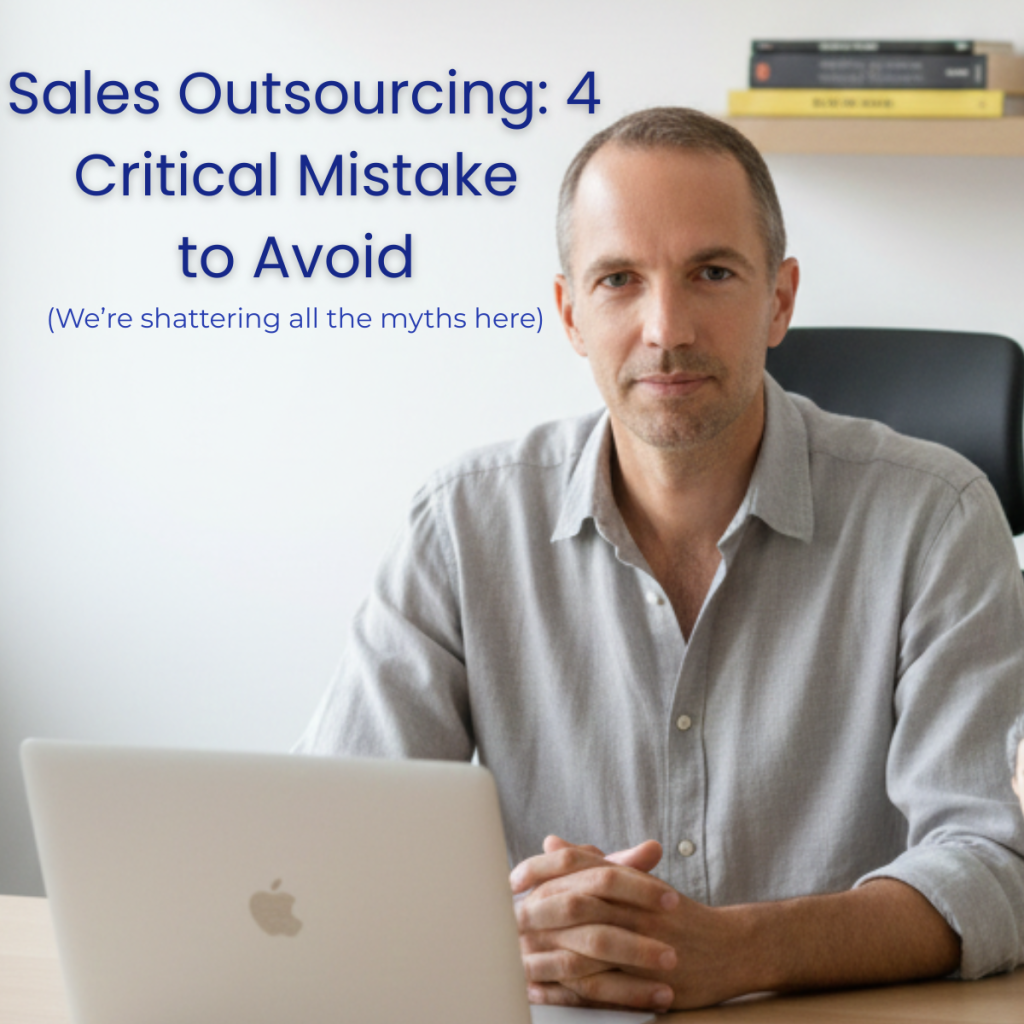Sales outsourcing is increasingly attractive to companies in 2025, as rapid digitalization, competitive pressure, and the need for agility drive new growth strategies.
The global business process outsourcing (BPO) market, which includes sales, is estimated at USD 323 billion in 2025, with projected annual growth of about 9.2% through 2035. Yet, when sales outsourcing is misunderstood, it can slow growth instead of accelerating it.
Here are 4 essential mistakes to avoid, with tips and recommendations to maximize your success.
1. Believing that “outsourcing means no longer managing anything”
It’s tempting to think that outsourcing means completely handing off your sales function. However, this myth destroys chances of success.
- 85% of successful companies outsource while actively co-piloting their project.
- It acts as a powerful revealer, clarifying both what works and what needs transformation.
- Outsourcing exposes internal blind spots: unclear value proposition, fuzzy ideal customer profiles (ICPs), unstable sales messaging.
Outsourcing hides nothing. It reveals what works and what needs improvement. For example, over 60% of companies identify through their partner hidden issues such as a vague value proposition, poorly defined ICPs in 3 out of 4 cases, or unstable sales messages.
That’s why sales outsourcing must be an active partnership based on trust. Your role is to share your vision, validate ICPs, and clarify the offer, while your partner structures, optimizes, and executes.
- Hold regular meetings during the first weeks to ensure strategic alignment.
- Fully commit to clearly defining and sharing your ideal customer profiles (ICPs).
- Use feedback from your provider to improve your offer and sales messages.
2. Reducing outsourcing to just lead prospecting
“Outsourcing? It’s just someone prospecting for me.” This limited view prevents companies from tapping the full potential of this model. In reality, prospecting represents only about 30% of the work of a high-performing outsourced sales team.
The bulk of the work, 70%, is done even before the first contact: strategic management, precise segmentation, personalized message crafting, clear positioning, thorough market analysis, and continuous campaign optimization.
- Difference between raw prospecting and intelligent prospecting.
- Importance of clear positioning.
- Building an outbound sales system.
- Why analysis and management are the real levers for success.
Thus, a well-organized outsourced team doesn’t just focus on volume. It builds a smart, structured, results-driven approach, allowing 85% of client companies to significantly increase open and conversion rates. This strategic method turns cold markets into opportunities rich in value.
- Request a comprehensive strategic plan from your provider, not just basic prospecting actions.
- Emphasize the importance of message personalization and data analysis.
- Establish metrics to measure lead quality and conversion rates.
For more guidance, see: Why Outsource your Sales Prospecting?
3. Expecting immediate results
Another persistent myth: “Outsourced prospecting should deliver appointments in the first week.” However, quality sales performance is built progressively. It requires a period of adjustment, testing, optimization, and strategic alignment.
- Calibration phase: messages, segmentation, ICP validation.
- Analysis of initial feedback.
- Ongoing sequence optimization.
Gradual ramp-up.
Moreover, the most important early indicators are not appointments, but open rates, response rates, message reactions, segmentation, and market interest. Therefore, companies that succeed don’t seek rapid miracles. They understand the need for a sustainable, solid, and profitable strategy.
- Be patient: treat prospecting as an evolving process.
- Monitor key indicators to adjust messages and sequences.
- Focus on a sustainable strategy over immediate results.
For more guidance, see: How to Gain Efficiency with Sales Outsourcing?
4. Comparing outsourcing costs to an internal salesperson’s salary
Many executives compare the cost of outsourced services to the salary of an internal sales representative. This comparison is misleading. The real cost of an internal rep includes training, tools, management, CRM, data, supervision, holidays, turnover risks—and sometimes a bad hire that multiplies costs.
By contrast, outsourcing provides a whole team, methodology, tools, management, structure, and immediate execution.
Advantages of the outsourced sales model:
- Speed of execution.
- Risk mitigation.
Therefore, you pay not for “one person,” but for a full-fledged sales department.
- Calculate the full cost of an internal salesperson for a fair comparison.
- Consider the added value of tools and management provided by the outsourcing partner.
- Prefer providers who can dynamically adjust resources to your real-time needs.
For more guidance, see: Succeeding in Sales Outsourcing: the key stages

Conclusion: Are you truly ready to be effectively sold to?
The question is not: “Should I outsource my sales force?” but rather: Is my company ready to onboard a high-performing sales team?
When managed well, sales outsourcing is an exceptional lever that drives growth precisely, quickly, and effectively. Its potential is immense for those willing to engage with clarity and ambition.
To assess if your company is ready, a simple diagnostic can shed light.
Now that you have a clear idea of where to start, build strong strategic partnerships where trust and performance combine to accelerate your growth.
If you found this article useful, feel free to share it with someone who might be interested, or simply on your favorite network.

